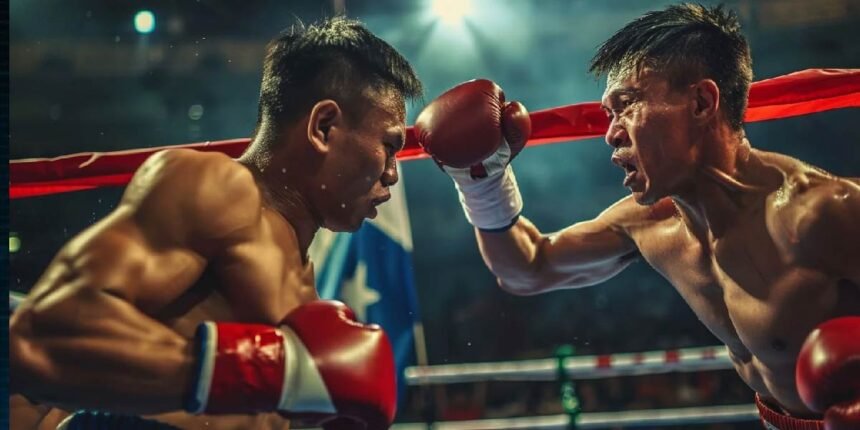What Are Panantukan DVDs?
Panantukan DVDs are more than just martial arts training videos—they are cultural blueprints that preserve one of the most practical and fluid self-defense systems in the world. Panantukan, often referred to as “Filipino boxing” or “dirty boxing,” has its roots in Filipino martial arts (FMA), and Panantukan DVDs serve as one of the most accessible ways for practitioners to learn this discipline. These DVDs offer in-depth instruction, cultural context, and a structured training path for students who may not have access to live instructors.
In an age where online content dominates learning, Panantukan DVDs continue to be a reliable source of traditional knowledge, favored by those who value physical ownership, in-depth explanations, and high-quality demonstrations. They are especially important today as there is a resurgence in realistic self-defense training methods, and many martial artists are turning away from sports-based systems in favor of practical, street-ready techniques that Panantukan uniquely provides.
Understanding Panantukan – The Art of Filipino Boxing
Panantukan is the empty-hand component of Filipino martial arts. Unlike traditional Western boxing, Panantukan includes not only punches but also elbow strikes, headbutts, shoulder bumps, forearm smashes, and limb destructions. It is designed for chaos, adaptability, and close-range efficiency. Known as “dirty boxing,” it is far from sport-focused—it is a street combat system intended to quickly disable an opponent using biomechanics, timing, and anatomical targets.
Panantukan is deeply integrated with Kali and Eskrima, the blade and stick arts of the Philippines. This integration allows a practitioner to seamlessly transition from weapon-based techniques to empty-hand applications, making it one of the most comprehensive self-defense systems available. Through Panantukan DVDs, students can explore this brutal and beautiful art form, studying its principles, flow, and devastating techniques in a way that connects modern learners to an ancient warrior legacy.
Historical Role of DVDs in Martial Arts Training
In the late 1990s and early 2000s, the martial arts world experienced a shift with the rise of DVDs replacing VHS tapes. While arts like Karate, Taekwondo, and Brazilian Jiu-Jitsu enjoyed commercial success through gyms and competitions, Panantukan remained an underground, instructor-dependent discipline. Panantukan DVDs played a critical role in bridging this gap. They allowed rare instruction, often passed down privately through lineage, to reach a global audience.
Students who lived in areas with no FMA schools could now train by watching detailed demonstrations of strikes, footwork, drills, and sparring. This era marked the beginning of the digital preservation of Filipino martial traditions. While other martial arts flooded the market with flashy, commercialized content, Panantukan DVDs remained raw, real, and focused on practicality—something highly respected by serious martial artists and law enforcement professionals.
Why Panantukan DVDs Matter Today
Despite the digital age’s dominance in online courses and streaming platforms, Panantukan DVDs continue to be highly valued. They offer offline access, which is essential in areas with limited internet or for practitioners who prefer distraction-free learning. Moreover, owning a physical DVD means lifetime access without the risk of it being removed from a subscription platform.
Panantukan DVDs also maintain their appeal because many of them were created by instructors who no longer teach or who have since passed away, turning these DVDs into irreplaceable archives of knowledge. For martial artists seeking depth, authenticity, and traditional insights, Panantukan DVDs provide an experience that modern, overly polished online content often lacks. These discs encapsulate not just technique, but also the philosophies, stories, and cultural richness of Filipino fighting arts.
Key Features of a High-Quality Panantukan DVD
A high-quality Panantukan DVD distinguishes itself through structured instruction, conceptual depth, and practical applications. Rather than focusing on isolated moves, these DVDs often teach principles like angle of attack, timing of destruction, and control of balance. Flow drills—like guntings (nerve strikes and destructions), chain punches, and parry-hubud transitions—form the foundation of the training.
Additionally, scenario-based training is a hallmark of Panantukan DVDs, helping practitioners visualize real-world confrontations. Some also include weapon integration modules, blending knife and stick transitions into empty-hand flows. The instructional style is typically no-nonsense and direct, filmed in studios or realistic outdoor settings without cinematic distractions. The best DVDs go further by breaking down body mechanics, footwork, and rhythm, allowing learners to not just copy a move but understand the system behind it.
Famous Instructors and Notable DVD Series
Several instructors have made significant contributions to the legacy of Panantukan DVDs. Ron Balicki, a student of Dan Inosanto and a practitioner of Jeet Kune Do and Silat, is widely respected for his instructional series that bridges Panantukan with modern combatives and JKD concepts. Doug Marcaida, known from the TV show “Forged in Fire,” is another influential figure whose DVDs emphasize the fluid, explosive nature of Panantukan as it relates to edged weapons and flow-based movement.
Kelly Worden, with his hybrid approach, has offered content that merges Panantukan with stick fighting and tactical self-defense. Dan Inosanto himself, one of Bruce Lee’s most senior students, has shared essential elements of Panantukan in various FMA compilations. These instructors, through their DVDs, have made Panantukan accessible to thousands of students across the globe and ensured the preservation of this rare art.
Training Alone – The Benefits and Limitations of DVD Learning
Training Panantukan using DVDs can be incredibly rewarding, but also comes with limitations. The biggest advantage is accessibility—you can learn anytime, pause, rewind, and rewatch difficult sections. It’s ideal for solo practitioners or those without local instructors. DVDs promote self-paced learning, and consistent repetition helps solidify motor skills. However, learning without live feedback means there’s a risk of developing poor habits, especially in timing, distance, and partner sensitivity.
Panantukan is a reactive art that thrives on pressure and fluidity, and these aspects are harder to grasp in solo training. To address this, many learners use Panantukan DVDs as supplementary material while attending in-person classes or virtual seminars. Peer-based training groups are also common, where a small community trains together using the DVDs as a shared curriculum.
From Physical Discs to Streaming – The Shift to Digital
With the growth of martial arts e-learning, many Panantukan DVDs are now available in digital formats. Websites and platforms offer downloads or subscription-based streaming for easier access. This shift has made Panantukan training more mobile and convenient.
However, there’s still a strong following that prefers physical DVDs. These practitioners value the disc’s permanence—no fear of deletion, paywalls, or subscription changes. Some instructors have even kept their material exclusive to DVDs, adding to the mystique and rarity of their teachings. For collectors and serious students, owning the original disc is not just about training—it’s about preserving an important piece of martial history that may not exist online in the future.
Cultural Significance and Identity Preservation
Panantukan DVDs are more than technical tutorials; they are living documents of Filipino heritage. In the face of globalization and cultural homogenization, these DVDs preserve indigenous knowledge systems passed down through generations. For Filipino-Americans and the broader diaspora, discovering these DVDs is a powerful act of cultural reclamation. They reconnect learners to ancestral roots, traditional values, and the warrior ethos that defined Filipino society long before modern colonization.
Additionally, academic researchers are beginning to examine Panantukan DVDs as primary source material in cultural and ethnographic studies. The content, often accompanied by storytelling, historical references, and warrior philosophy, serves as a testament to the depth and dignity of Filipino martial traditions.
Panantukan in Modern Combatives and Security Training
The rise of combatives training in military, police, and personal defense circles has increased interest in Panantukan. Its techniques—limb destruction, angle manipulation, close-quarters control—fit perfectly into real-world self-defense. Panantukan DVDs have quietly influenced this space, with some being rebranded as “urban combatives” or “survival systems.” Many instructors adapt the principles found in these DVDs to tactical environments, using them in scenarios involving knives, confined spaces, or multiple attackers.
The practicality of Panantukan has made it popular among law enforcement and private security trainers looking for systems that prioritize speed, efficiency, and survivability. These DVDs often provide street scenario drills, environmental awareness, and weapon transition strategies, offering critical knowledge that goes beyond sport martial arts.
Future of Panantukan Instruction – AI, Apps, and Innovation
While Panantukan DVDs have served generations of learners, the future of instruction is rapidly evolving. Developers are now creating motion capture apps and AI-enhanced training tools that can analyze a student’s form, timing, and technique in real time. Virtual reality (VR) environments may soon allow students to spar with simulated opponents or instructors using Panantukan principles. Augmented reality (AR) overlays could guide hand placements, footwork, and timing drills in real-time settings.
Despite these advances, many practitioners believe that the core wisdom preserved in Panantukan DVDs—the feel, the grit, the intent—cannot be fully replicated in digital simulations. The human instruction, raw motion, and cultural nuance captured on film make DVDs a timeless resource.
Collecting and Preserving Panantukan DVDs
As many Panantukan DVDs are now out of print, a passionate community of collectors has emerged. Martial arts forums, auction sites, and expos often feature rare titles at premium prices. Some enthusiasts view collecting Panantukan DVDs not only as a way to access instruction but as an effort to preserve a martial heritage that could be lost. Preservation projects are also underway, where individuals digitize their personal libraries to safeguard these teachings for future generations. These collectors act as archivists, curators of a tradition that exists largely outside mainstream recognition. The effort to preserve Panantukan DVDs echoes a larger mission—to maintain cultural identity and combat arts knowledge in a world increasingly detached from physical tradition.
Final Thoughts
In a time when martial arts have become commodified and overly commercialized, Panantukan DVDs stand as honest, unfiltered expressions of a living martial culture. They are not just tools for learning—they are blueprints of survival, records of identity, and testaments to human adaptability. Whether you are a martial artist, cultural researcher, or simply someone looking to understand the deeper layers of combat, these DVDs offer something no algorithm can replace—authentic, embodied wisdom. As martial culture continues to evolve digitally, Panantukan DVDs remain grounded in tactile tradition, bridging the old and the new. Their value is not just in what they teach—but in what they preserve.
FAQs About Panantukan DVDs
1: What is Panantukan in martial arts?
Panantukan is a Filipino martial art also known as “dirty boxing.” It focuses on real-life self-defense using punches, elbows, headbutts, limb destruction, and low kicks. It is practical, fast, and designed for street situations, not sports competition.
2: What are Panantukan DVDs used for?
Panantukan DVDs are used for learning Filipino boxing at home. They show techniques, drills, and strategies for close-combat self-defense. These DVDs are great for solo practice, cultural learning, or improving real-world fighting skills.
3: Are Panantukan DVDs good for beginners?
Yes, many Panantukan DVDs are beginner-friendly. They start with simple moves and explain each step clearly. Beginners can follow along at their own speed and build skills even without a martial arts background.
4: Can I train Panantukan without a partner using DVDs?
Yes, you can train solo with Panantukan DVDs. Many drills focus on movement, timing, and form. However, practicing with a partner later is helpful to understand real reactions and improve timing.
5: Why are Panantukan DVDs still popular today?
Panantukan DVDs are still popular because they offer real, practical training and preserve Filipino martial culture. They are also easy to use offline, collectable, and often include rare lessons from expert instructors.
For More Information Visit Fourmagazine







